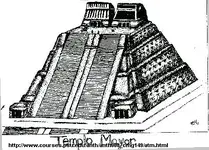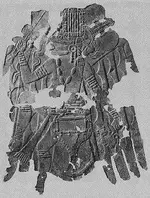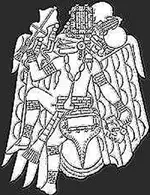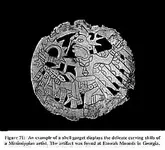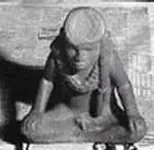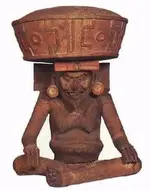Highmountain also wrote:
Clearing the slate for a sub-sub-sub thread of this thread that assumes
1] "The Aztec arrived in great numbers from the north" in the time of the grandfathers of the Spanish allied tribes [Bernal Diaz], and,
2] The copper plate found in the Georgia Etowah mound depicts the Aztec diety Ehecatl and the Mississippian preoccupation with snakes in their religious depictions is significant, rather than coincidental, and,
3] Some large faction among the mound builders occupied a place in the direct cultural and ancestral heritage of the Aztec.
I'd be interested in pursuing the idea a bit to see where it leads if anyone shares that interest. I don't mind doing it here, but I'm not married to that approach and can just as easily do it privately or on some other forum.
If you would prefer to limit the discussion to this set of precepts,
I have zero problems with this approach; there is no need to take it to PM format or to another forum, certainly
not on my account.
So,
starting from this set of precepts - if a large faction among the Mound Builders were to separate from the main tribe, what would be the most likely motive? (This is pure speculation on my part - tribes could split over quite trivial matters that seem almost foolish in retrospect) It is a matter of historical record that many Amerindian tribes came about due to a division among the people, which is why there were Plains Apaches versus Mescalero, Chiricahua, etc and Northern and Southern Cheyenne for instance. Since the language of the Aztecs is or
was Nahuatl, it is logical that the language of their ancestors must be related to this - and here is our first stumbling block.
Just looking at a single example (for starters) the Etowah mounds of Georgia, which are accepted as a part of the Mound Builder culture. For a long time the builders were assumed to be Iroquoian-speaking Cherokees, until recently when it has been shown that the builders were Muskogean-speaking Creeks. Nahuatl is a branch of the Uto-Aztecan family, and geographically is largely centered in Mesoamerica. This could be just a
red herring too, for we can not prove that the Etowah mounds were built by the same culture of those who built impressive mounds through middle-America
beyond all doubt. It is also possible that a group that split off from the main Mound-builders might well have adopted the language in the region they emigrated to, perhaps retaining only a few words of their original tongue. In fact, considering the military-political position of the Aztec tribes on their arrival in central Mexico, (a tributary people, described as "
barely ekeing out a precarious existence" for some time) it is not illogical that they might adopt the language of the tribe(s) in power, much as they adopted the architectural style of the earlier Teotihuacanos. We can point to many historical examples where a 'conquered' or tributary people adopted the language of their conquerers over time, just look at how widely Latin spread in the Roman empire for instance.
Then too, the Etowah mounds are likely of the Mississippian mound-builder culture, which is the only type of Mound Builder which remained in existence during the period when the Aztecs emigrated. (As far as I know) The tribes believed by historians to have Mississippian-culture roots are:
the Alabama, Apalachee, Caddo, Cherokee, Chickasaw, Choctaw, Creek, Guale, Hitchiti, Houma, Illinois, Kansa, Miami, Missouri, Mobilian, Natchez, Osage Nation, Quapaw, Seminole, Shawnee, Timucua, Tunica-Biloxi, Yamasee, and Yuchi. (
copied from Wiki, I believe it is correct but cannot check it against my own refs - I welcome any corrections and/or additions.)
All of these are either related or believed to be related linguistically to Muskogean language family. However, as we have touched on already - it is conceivable that the Aztecs adopted the language of the people living in central Mexico over time, much as they appear to have adopted architectural and religious systems. An alternate explanation for the linguistic differences between Aztec ancestors and the Muskogean family is that
they were an alien group within the Mississippians to begin with, in fact this idea would "fit" with their emigration and could be one key reason for their motivation to separate and live as far away as possible. If the Aztecs were speaking a different tongue from the "lords" of Aztlan, perhaps living in a subservient political/military position as well, we have
a strong motivator for the people to wish for a new homeland. So on to the next issue, which may have a key clue - ceramics.
A key cultural practice of the Mississippian Mound-builders was their use of aquatic shell tempering agents in hardening their ceramics. If the Aztecs also practiced this in their manufacture of ceramics, it would lend credence to the idea that they are directly related. Of course even if the Aztecs did emulate this practice, it is possible they had simply adopted or copied it from having contact with the Mound-builders. Anyone know what the case is viz Aztec ceramics, whether they also used river and/or marine shells as a hardening agent? Thank you in advance,
Highmountain, you mentioned that you are "not married" to this set of precepts (1,2, and 3 mentioned above) which I find to be an admirable and open-minded approach to the questions of history. Are there other variations or even completely different alternate ideas you would not mind discussing as well? Again, thank you in advance,
Good luck and good hunting amigos, I hope you find the treasures that you seek.
your friend,
Oroblanco




